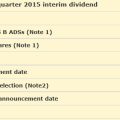What Is A Dividend? How To Invest In The Best Stocks That Pay Dividends
What Are Dividends?
Dividends are a great way for companies to distribute their profit among their owners (shareholders). This is a way for shareholders to generate income from the companies they own. A dividend is simply a payment by a company to its shareholders, it’s usually calculated as a certain amount per share (55 cents per share for instance). So everyone who owns shares of a company that pays a dividend will get the per-share amount multiplied by the number of his/her shares. Companies by default are not obliged to pay dividends, their management decides whether or not a dividend will be paid. Usually, mature and well-established companies choose to make dividend payments to their shareholders, and young businesses decide to reinvest their profits back into the business because they are usually hungry for cash and also to take advantage of their bigger potential for growth. However, there are certain types of companies that are obliged by law to pay a percentage of their profits as dividends on a regular basis. REITs, for example, have to redistribute at least 90% of their net income to their shareholders.
Who gets a dividend?
As we mentioned above, if you own at least one share of a company distributing dividends, you qualify for receiving payment. The more shares you own, the bigger the payment is. For more details, see below.
How much are dividends?
Dividends are paid per share. Companies announce the amount of the dividend per share on the declaration date and each shareholder gets a payment according to the number of shares she owns on the payment date. For example, if a company announces a $1.25 dividend per share and you have 100 shares of the company’s stocks, you are going to get a payment of $125$ on the payment date. This is how each owner of the company gets a fair share of the profit, according to the size of her stake.
How and When Are Dividends Paid?
Usually, dividends are paid annually, quarterly, and even monthly. Each company decides how and when to make such payments. It’s common for European companies to pay dividends once a year, while US companies usually pay dividends every quarter. There are also companies making monthly payments.
How To Start Getting Paid Dividends?
If you want to start receiving dividend payments, you have to buy shares of a company that pays dividends. However, there is no guarantee that a company will continue to make such payments in the future. Whether or not such payments will be made is optional for a company. There are corporations that have many years of consecutive dividend payments. This makes them more probable to continue doing so in the future. For example, there is a group of corporations called “the Dogs of the Dow” – they have not only paid dividends every year, for the last 25 years but also every time increased their payments. You can see these companies here.
Risks In Dividend Investing
Investing in dividend-paying companies is not risk-free. It’s stock market investing and this is a relatively risky endeavor. By buying stocks you actually become a co-owner in the business and businesses are anything but safe investments. Some of the main risks are:
- A company may cease its dividend payments – there might be many reasons for this like a loss, shortage of cash, change in management’s policy, and all stuff like these.
- A company may lower its dividends – this is far more probable than the first risk, this happens usually when a company is experiencing difficulties or during hard economic times.
- Decrease in share prices – to receive dividends you must own shares, but the price of these shares may vary because it’s determined by the market. A company may keep its dividends unchanged, but its share price may drop, and this way you will lose from your initial investment. For example, if you buy 100 shares at a price of $100, your investment is $10 000. If the share price drops to $90, your investment value will drop to $9 000 (100 shares multiplied by $90). The company may not have changed its dividend payment, you will still get your expected dividend but if the price drops you realize a capital loss.
Alternatives To Dividend Investing
There are plenty of alternatives to dividend investing. The investment world is so big that you can practically invest in everything – from tomatoes and wine to virtual things like bitcoin. Dividend-paying stocks are a great way for generating income because they have some good advantages. You can see them here: Pros and cons in dividend investing.
Is dividend investing still worth it today?
In recent years, investors have been less enthusiastic about dividend investing, preferring to focus instead on capital gains. But despite this shift, many experts still believe that dividend investing is still worth pursuing – provided that it’s part of a carefully balanced portfolio.
At its core, dividend investing is a strategy that involves investing in companies that regularly pay out a portion of their profits to shareholders in the form of a dividend. All other things being equal, a portfolio that includes dividend-paying stocks will generally offer investors a more predictable income stream than one that does not.
The downside, however, is that dividend stocks are less likely to realize significant capital gains than stocks that do not pay a dividend. This makes dividend investing less attractive to investors who are more interested in riding price appreciation.
So why is dividend investing still worth it today? Despite the fact that dividend investing does not always offer the same kind of capital appreciation opportunities as other investment strategies, it still offers a number of key benefits.
First, despite the fact that dividend yields have decreased in recent years, many investors still find them attractive. This is because dividend payments create a steady source of income that enables investors to pay themselves a regular “salary” as they wait out market fluctuations.
Second, a well-constructed dividend-paying portfolio is generally considered to be low-risk. Companies that pay dividends tend to be more established and stable, meaning that they are less likely to suffer significant declines than speculative stocks.
Finally, dividend payments generally increase over time. This means that investors can not only look forward to an additional source of income, but also the possibility of growing wealth over the long term.
In sum, while dividend investing may not offer the same kind of capital gains potential that other strategies do, it still has a place in every investor’s portfolio. Done correctly, a dividend-paying portfolio can not only provide a regular income stream but can also be used to build wealth over the long term.
Please, don’t forget to share this article with friends if you think it’s interesting reading. This way you will help us write more cool articles like this. Thanks!






